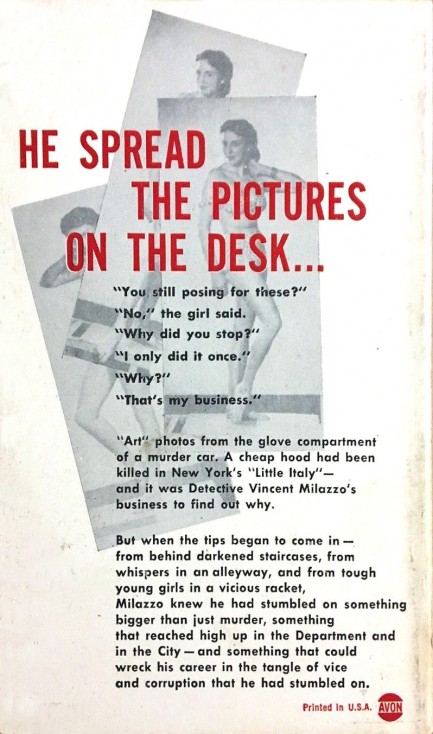 Mambo, rumba, merengue—you're great at them all. Have you by chance ever done a lap dance? 
James Meese was responsible for this nice front for David C. Holmes' 1958 thriller The Velvet Ape. The art features the alpha pose we've highlighted before, where the main subject is straddled by a-shaped legs. Here, the woman dances in the foreground, the man observes from an easy chair, and a gun-wielding shadow creeps toward them beyond the background doorway. Is the woman in league with the shadow? Or are both man woman and man in big trouble? Whatever the answers, Meese has taken an oft used motif and produced a nice example of it. You can see our alpha collection here. The book tells the story of former naval aviator Buck Tankersley, who after disgrace and a lost career has fetched up in Panama, where he mainly drinks. When another aviator working for a company called Gulf Export takes a fatal header off a balcony into an empty pool, the local CIA chief, who's concerned about communist incursions in Central America, enlists Tankersley to apply for the dead flyer's vacancy and be eyes and ears inside the company. Tankersley soon meets Marley Kentner, sister of the dead aviator, who's looking for answers. Those answers, somehow or other, hinge upon a set of Indian ape dolls made from velvet, gourds, and monkey fur.
Overall, we'd say The Velvet Ape falls into the strictly average category. For one thing, the Panamanian setting isn't exploited as well as it could be. In fact, in an effort to establish that setting, Holmes mangles the first Spanish phrase he tries to use. That isn't entirely his fault. His editors were supposed to catch such errors. But it encapsulates the issues with the book, which feels a little lazy. Its plot is from the anti-commie handbook and its characters aren't compelling. But on the plus side, the climax involves Tankersley flying a Grumman Mallard seaplane directly into a hurricane. Points for that. 
 You can go up if you guess what number I'm thinking. Hint: it has a dollar sign before it and two zeros after. 
Above: more nice work from illustrator James Meese, this time for David Loughlin's novel A Private Stair. It originally appeared in hardcover in 1950, with this Signet paperback edition coming in 1956.
 Baby, if God had meant for you to cover yourself he'd have given you three hands. 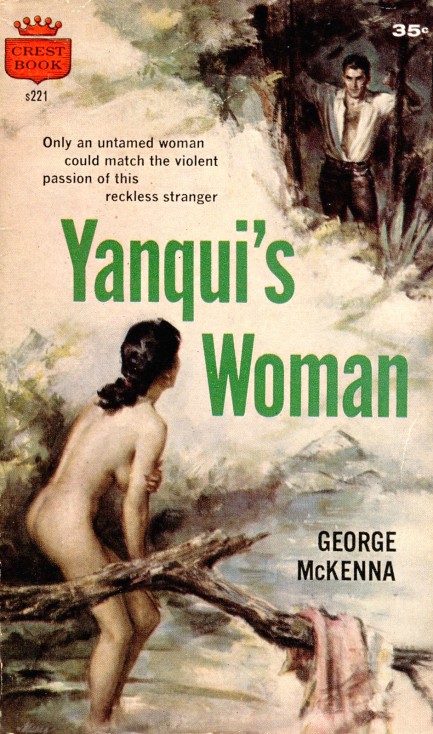
We've shared so many covers of unfortunate women being surprised while bathing in ponds and streams that we can't believe we missed this one by James Meese for George McKenna's 1958 novel Yanqui's Woman. Well, consider it an addition to the group, which is scattered in posts here, here, here, and here.
 I've almost got you! After I rescue you please don't feel any sense of gratitude that becomes confusingly sexual! 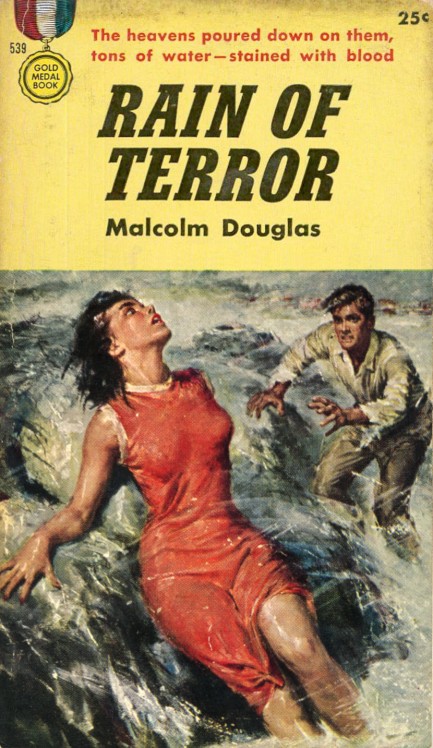
Yup, it's another disaster thriller. We told you we can't resist these. Rain of Terror was published in 1955 and came from Malcolm Douglas in a Gold Medal Edition fronted by James Meese cover art. The story takes place partly in Rome, but mainly in the fictitious Italian town of Asceno. We're always baffled when authors don't just choose a real town, but whatever. The Asceno area is being battered by a weeklong rainstorm, with flooding, looting, and chaos. Newspaperman Jake Abbott is sent to get the story. Once there, the waters nearly destroy the town, and a cache of long lost jewels appears, along with two Botticellis. The fight over these riches is predictable, but what isn't is Abbott's almost Kafkaesque nightmare as he's trapped in a town that becomes like a labyrinth. His misadventures, romantic entanglements, arrests, beatings, and wrong turns read like farce or metaphor. Rain of Terror isn't as good as other disaster thrillers we've read, but it's memorable.
 This little baby is going to revolutionize the sex toy industry. And the best part is I can fly it directly to buyers. 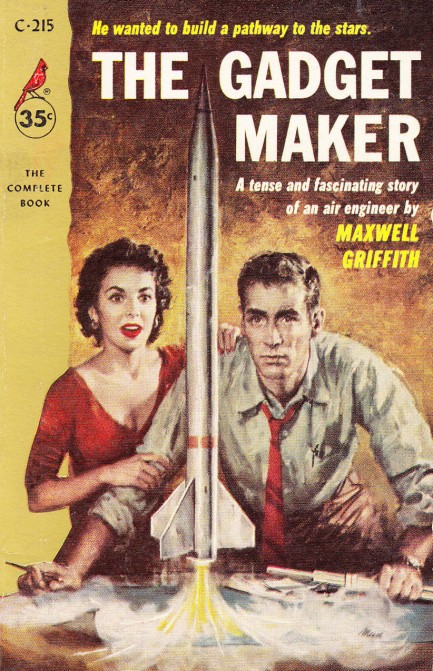
We can send billionaires into orbit but we can't invent self-delivering sex toys? Seriously? We don't think it's a lack of brainpower so much as a case of backward priorities. All those scientists need to think less about outer space, and more about inner space. There's still so much to be discovered there. 1956 copyright on this, with James Meese cover art.
 This absolutely sucks. Next time grandma needs a basket of food I'm telling her to order it from Uber Eats. 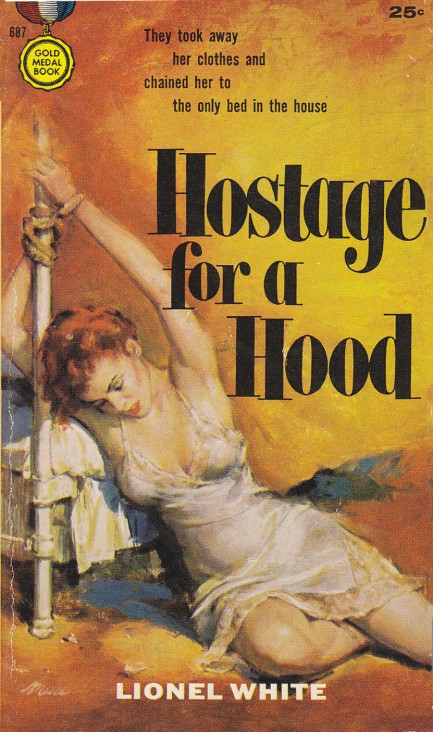
Have you heard the story of Little Red Riding with Hoods? It's a classic. Little Red Riding with Hoods leaves her cottage one day intent on buying a gift with a cashier's check. She crashes into a carload of bank robbers, and since their vehicle is now disabled, they steal hers—with her in it. They flee to their hideout, and thereafter are divided over what to do with Red. But the debate is short. They all know she's a witness and must be killed, which makes efforts by the cops a race against time. Crucially, they've lost some of that time because when the cops find out about the cashier's check they think Red has run away to start a new life. But they finally uncover a salesman who's owed for the gift Red ordered, and at that point realize she has indeed been kidnapped and probably doesn't have long to live. How does it all end? Well, we can tell you this—the book could have gone all sorts of places, but in 1957 when Lionel White published it, is there any doubt Red lives happily ever after? You sense it early and grow more certain with each page. But don't yell spoiler at us—Hostage for a Hood is still a good read, foregone conclusion and all.
 I know it isn't exactly Tahiti, baby, but it's warm, cheap, and there aren't any COVID restrictions. 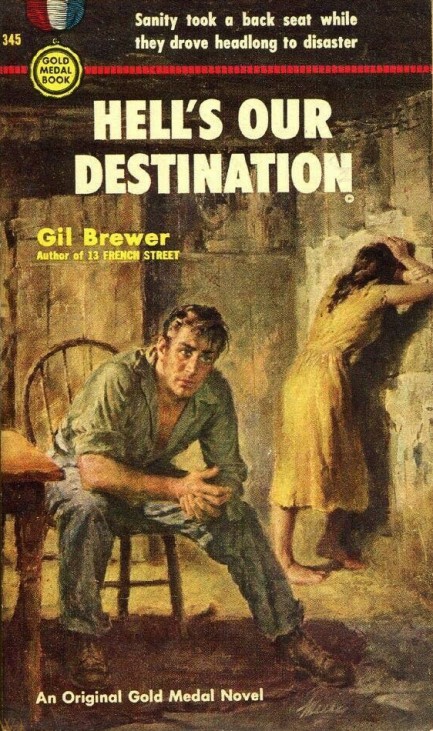
We're fans of illustrator James Meese. His covers are easy to caption. Remember Fort Everglades? How about Amazon Head-Hunters? We don't know if credit goes to him for the interesting moments his chose for his work, or if the publishers who employed him were responsible, but we'll take it. Above is another—Gil Brewer's 1953 novel Hell's Our Destination, with a couple who look like they've just realized their non-refundable AirBnB is right over a country/western dance bar that stays open until sunrise.
 I'm not worried. I know something you don't. I'm the star of an entire series. 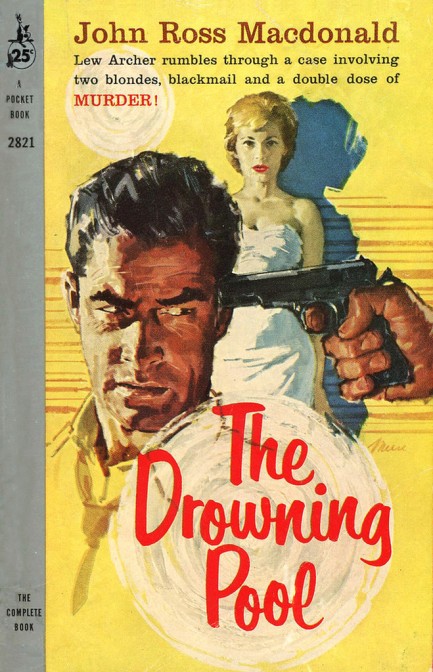
Above, a 1959 cover painted by James Meese for John Ross MacDonald's 1950 thriller The Drowning Pool. We looked at a 1951 cover for this a while back, but rather than talk about the story made some dumb jokes and called it a day. So about the book. The novel features franchise detective Lew Archer trying to solve a drowning murder while dealing with a family torn apart over an inheritance. Liking the book is a matter of liking the character. Archer is cynical, quippy, and pretty rude most of the time—in short, a typical mid-century fictional detective. And therein lies the issue. He's standard, which means the mystery needs to be unique, but instead it's a drop-off from the series debut The Moving Target. It's not bad, though, and consensus is the eighteen Archer adventures improve as they progress. We'll see, because we plan to keep reading them. Hopefully Archer will make us glad he survived this gun to his head.
 That was a real interesting story. I bet the cops would've loved to hear it. 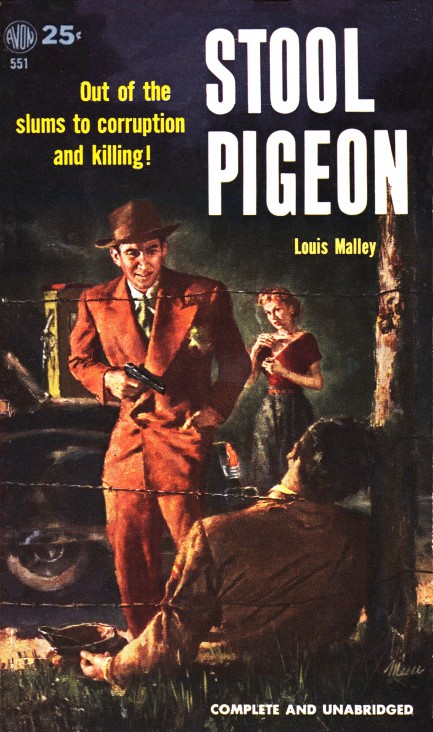
Louis Malley's 1953 cop thriller Stool Pigeon might better be called “Stool Pigeons,” because it's about how crime solving hinges on a network of informants, and how reliable snitches make average detectives great. All the detectives in the book have their own, and they're sometimes kept so secret that nobody else on the police force knows who they are. If an informant's identity ever gets out they usually go from stool pigeon to cooked goose, as shown in the cover scene painted by James Meese. As we read this book we kept expecting one of the multiple stool pigeons to emerge as pivotal, and that's exactly what happens. We won't tell you which one proves most important, but we will say Malley takes a fresh angle on the typical cop novel and does it reasonably well.
 He's been eaten down to the bones. I don't know about you but this is by far the worst case of frostbite I've ever seen. 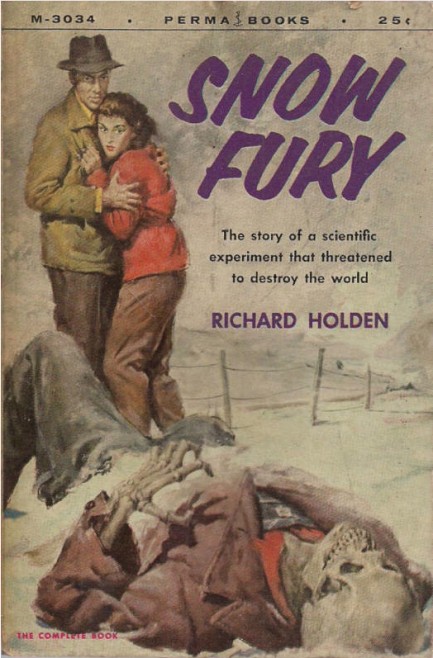
We imagine Boston born author James Holden sitting around one bitterly cold night, probably just a little tipsy from drinking warm brandy, staring out at a December snowstorm, thinking to himself that if anyone's out there in such terrible weather they're risking frostbite. And then his eyes grow wide and he says aloud, “What if the frost... takes more... than just a bite? Yes! Writer's block cured!” And some months later he finishes Snow Fury, in which the snow eats people entirely. Yep. How could snow eat people? Might have something to do with a scientific experiment run amok. And just to push the entire concept to full fruition Holden named the main character David Storm. Well, at least the cover is brilliant, and for that you can thank James Meese. This Perma edition is from 1956 and the book originally appeared in hardback in 1955.

|
 |

The headlines that mattered yesteryear.
2003—Hope Dies
Film legend Bob Hope dies of pneumonia two months after celebrating his 100th birthday. 1945—Churchill Given the Sack
In spite of admiring Winston Churchill as a great wartime leader, Britons elect
Clement Attlee the nation's new prime minister in a sweeping victory for the Labour Party over the Conservatives. 1952—Evita Peron Dies
Eva Duarte de Peron, aka Evita, wife of the president of the Argentine Republic, dies from cancer at age 33. Evita had brought the working classes into a position of political power never witnessed before, but was hated by the nation's powerful military class. She is lain to rest in Milan, Italy in a secret grave under a nun's name, but is eventually returned to Argentina for reburial beside her husband in 1974. 1943—Mussolini Calls It Quits
Italian dictator Benito Mussolini steps down as head of the armed forces and the government. It soon becomes clear that Il Duce did not relinquish power voluntarily, but was forced to resign after former Fascist colleagues turned against him. He is later installed by Germany as leader of the Italian Social Republic in the north of the country, but is killed by partisans in 1945.
|

|
|

It's easy. We have an uploader that makes it a snap. Use it to submit your art, text, header, and subhead. Your post can be funny, serious, or anything in between, as long as it's vintage pulp. You'll get a byline and experience the fleeting pride of free authorship. We'll edit your post for typos, but the rest is up to you. Click here to give us your best shot.

|
|



















